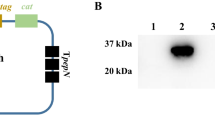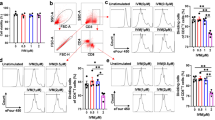Abstract
Botulinum neurotoxin (BoNT) is a neurotoxin produced by Clostridium botulinum in an anaerobic environment. BoNT is the most toxic protein among bacteria, animals, plants, and chemical substances reported to date. BoNTs are 150 kDa proteins composed of three major functional domains: catalytic (L domain, 50 kDa), translocation (HN domain, 50 kDa), and receptor-binding (Hc domain, 50 kDa) domains. Most studies have focused on the use of the Hc domain as an antigen because it is capable of generating robust protective immunity and contains some functional neutralizing epitopes. In the present study, we produced and characterized a recombinant L-HN fusion fragment of the parent BoNT/B (BL-HN) composed of L and HN domains with a deletion in the Hc domain (BHc). When the BL-HN protein was expressed in E. coli, it retained its stable structure and antigenicity. As a vaccine antigen, the recombinant BL-HN protein was found to induce sufficient protection against native BoNT/B in a mouse model. The BL-HN subunit vaccine could also induce a strong humoral immune response and generate sufficient neutralizing antibodies in immunized mice. Therefore, BL-HN may retain the native neurotoxin structure and critical epitopes responsible for inducing serum neutralizing antibodies. Studies of the dose-dependent immunoprotective effects further confirmed that the BL-HN antigen could provide potent protective immunity. This finding suggests that BL-HN can play an important role in immune protection against BoNT/B. Therefore, the BL-HN fusion fragment provides an excellent platform for the design of recombinant botulinum vaccines and neutralizing antibodies.





Similar content being viewed by others
Abbreviations
- BoNT:
-
Botulinum neurotoxin
- BHc:
-
The Hc domain of BoNT/B
- BL-HN:
-
Recombinant L-HN fusion fragment of the parent BoNT/B composed of L and HN domains
- LD50 :
-
50% Mouse lethal dose
- GMT:
-
Geometric mean titer
- ED50 :
-
The 50% percent effective concentrations
- PBS:
-
Phosphate-buffered saline
- ELISA:
-
Enzyme-linked immunosorbent assay
- TBS:
-
Tris-buffered saline
References
Ayyar BV, Tajhya RB, Beeton C, Atassi MZ (2015) Antigenic sites on the HN domain of botulinum neurotoxin A stimulate protective antibody responses against active toxin. Sci Rep 5:15776. https://doi.org/10.1038/srep15776
Baldwin MR, Tepp WH, Przedpelski A, Pier CL, Bradshaw M, Johnson EA, Barbieri JT (2008) Subunit vaccine against the seven serotypes of botulism. Infect Immun 76:1314–1318. https://doi.org/10.1128/IAI.01025-07
Barash JR, Arnon SS (2014) A novel strain of Clostridium botulinum that produces type B and type H botulinum toxins. J Infect Dis 209(2):183–191. https://doi.org/10.1093/infdis/jit449
Berger T, Eisenkraft A, Bar-Haim E, Kassirer M, Aran AA, Fogel I (2016) Toxins as biological weapons for terror-characteristics, challenges and medical countermeasures: a mini-review. Disaster Mil Med 2:7. https://doi.org/10.1186/s40696-016-0017-4
Chen C, Wang S, Wang H, Mao X, Zhang T, Ji G, Shi X, **a T, Lu W, Zhang D, Dai J, Guo Y (2012) Potent neutralization of botulinum neurotoxin/B by synergistic action of antibodies recognizing protein and ganglioside receptor binding domain. PLoS ONE 7:e43845. https://doi.org/10.1371/journal.pone.0043845
Cheng LW, Henderson TD 2nd, Lam TI, Stanker LH (2015) Use of monoclonal antibodies in the sensitive detection and neutralization of botulinum neurotoxin serotype B. Toxins 7:5068–5078. https://doi.org/10.3390/toxins7124863
Davies JR, Liu SM, Acharya KR (2018) Variations in the Botulinum Neurotoxin Binding Domain and the Potential for Novel Therapeutics Toxins 10 https://doi.org/10.3390/toxins10100421
Dong M, Masuyer G, Stenmark P (2019) Botulinum and tetanus neurotoxins. Annu Rev Biochem 88:811–837. https://doi.org/10.1146/annurev-biochem-013118-111654
Fan Y, Dong J, Lou J, Wen W, Conrad F, Geren IN, Garcia-Rodriguez C, Smith TJ, Smith LA, Ho M, Pires-Alves M, Wilson BA, Marks JD (2015) Monoclonal antibodies that inhibit the proteolytic activity of botulinum neurotoxin serotype/B. Toxins 7:3405–3423. https://doi.org/10.3390/toxins7093405
Foster KA (2009) Engineered toxins: new therapeutics. Toxicon 54:587–592. https://doi.org/10.1016/j.toxicon.2009.01.037
Garcia-Rodriguez C, Geren IN, Lou J, Conrad F, Forsyth C, Wen W, Chakraborti S, Zao H, Manzanarez G, Smith TJ, Brown J, Tepp WH, Liu N, Wijesuriya S, Tomic MT, Johnson EA, Smith LA, Marks JD (2011) Neutralizing human monoclonal antibodies binding multiple serotypes of botulinum neurotoxin. Protein Eng Des Sel 24:321–331. https://doi.org/10.1093/protein/gzq111
Janik E, Ceremuga M, Saluk-Bijak J, Bijak M (2019) Biological Toxins as the Potential Tools for Bioterrorism Int J Mol Sci 20 https://doi.org/10.3390/ijms20051181
Jones RG, Liu Y, Rigsby P, Sesardic D (2008) An improved method for development of toxoid vaccines and antitoxins. J Immunol Methods 337:42–48. https://doi.org/10.1016/j.jim.2008.05.009
Khouri JM, Motter RN, Arnon SS (2018) Safety and immunogenicity of investigational recombinant botulinum vaccine, rBV A/B, in volunteers with pre-existing botulinum toxoid immunity. Vaccine 36:2041–2048. https://doi.org/10.1016/j.vaccine.2018.02.042
Liu B, Shi D, Chang S, Gong X, Yu Y, Sun Z, Wu J (2015) Characterization and immunological activity of different forms of recombinant secreted Hc of botulinum neurotoxin serotype B products expressed in yeast. Sci Rep 5:7678. https://doi.org/10.1038/srep07678
Liu FJ, Shi DY, Mao YY, **ong XH, Lu JS, Pang XB, Dong XJ, Yang ZX, Yu YZ (2020) Immunological characterisation and immunoprotective efficacy of functional domain antigens of botulinum neurotoxin serotype A. Vaccine 38:2978–2983. https://doi.org/10.1016/j.vaccine.2020.02.060
Lou J, Marks JD (2018) Botulinum Neurotoxins (BoNTs)-Antibody and Vaccine Toxins 10 https://doi.org/10.3390/toxins10120495
Masuyer G, Beard M, Cadd VA, Chaddock JA, Acharya KR (2011) Structure and activity of a functional derivative of Clostridium botulinum neurotoxin B. J Struct Biol 174:52–57. https://doi.org/10.1016/j.jsb.2010.11.010
Masuyer G, Stancombe P, Chaddock JA, Acharya KR (2011) Structures of engineered Clostridium botulinum neurotoxin derivatives. Acta Crystallogr Sect F Struct Biol Cryst Commun 67:1466–1472. https://doi.org/10.1107/S1744309111034671
Matsumura T, Amatsu S, Misaki R, Yutani M, Du A, Kohda T, Fujiyama K, Ikuta K, Fu**aga Y (2020) Fully Human Monoclonal Antibodies Effectively Neutralizing Botulinum Neurotoxin Serotype B Toxins 12 https://doi.org/10.3390/toxins12050302
Meng Q, Garcia-Rodriguez C, Manzanarez G, Silberg MA, Conrad F, Bettencourt J, Pan X, Breece T, To R, Li M, Lee D, Thorner L, Tomic MT, Marks JD (2012) Engineered domain-based assays to identify individual antibodies in oligoclonal combinations targeting the same protein. Anal Biochem 430:141–150. https://doi.org/10.1016/j.ab.2012.08.005
Moreira GM, Cunha CE, Salvarani FM, Goncalves LA, Pires PS, Conceicao FR, Lobato FC (2014) Production of recombinant botulism antigens: a review of expression systems. Anaerobe 28:130–136. https://doi.org/10.1016/j.anaerobe.2014.06.003
Pirazzini M, Rossetto O, Eleopra R, Montecucco C (2017) Botulinum neurotoxins: biology, pharmacology, and toxicology. Pharmacol Rev 69:200–235. https://doi.org/10.1124/pr.116.012658
Pittman PR, Hack D, Mangiafico J, Gibbs P, McKee KT Jr, Friedlander AM, Sjogren MH (2002) Antibody response to a delayed booster dose of anthrax vaccine and botulinum toxoid. Vaccine 20:2107–2115. https://doi.org/10.1016/s0264-410x(02)00058-0
Rasetti-Escargueil C, Avril A, Chahboun S, Tierney R, Bak N, Miethe S, Mazuet C, Popoff MR, Thullier P, Hust M, Pelat T, Sesardic D (2015) Development of human-like scFv-Fc antibodies neutralizing Botulinum toxin serotype B. MAbs 7:1161–1177. https://doi.org/10.1080/19420862.2015.1082016
Rasetti-Escargueil C, Popoff MR (2019) Antibodies and Vaccines against Botulinum Toxins: Available Measures and Novel Approaches Toxins 11 https://doi.org/10.3390/toxins11090528
Rossetto O, Montecucco C (2019) Tables of Toxicity of Botulinum and Tetanus Neurotoxins Toxins 11 https://doi.org/10.3390/toxins11120686
Sahay B, Colliou N, Zadeh M, Ge Y, Gong M, Owen JL, Valletti M, Jobin C, Mohamadzadeh M (2018) Dual-route targeted vaccine protects efficiently against botulinum neurotoxin A complex. Vaccine 36:155–164. https://doi.org/10.1016/j.vaccine.2017.11.008
Shearer JD, Manetz TS, House RV (2012) Preclinical safety assessment of recombinant botulinum vaccine A/B (rBV A/B). Vaccine 30:1917–1926. https://doi.org/10.1016/j.vaccine.2012.01.035
Shearer JD, Vassar ML, Swiderski W, Metcalfe K, Niemuth N, Henderson I (2010) Botulinum neurotoxin neutralizing activity of immune globulin (IG) purified from clinical volunteers vaccinated with recombinant botulinum vaccine (rBV A/B). Vaccine 28:7313–7318. https://doi.org/10.1016/j.vaccine.2010.08.076
Shi DY, Chen BY, Mao YY, Zhou G, Lu JS, Yu YZ, Zhou XW, Sun ZW (2019) Development and evaluation of candidate subunit vaccine against botulinum neurotoxin serotype B. Hum Vaccin Immunother 15:755–760. https://doi.org/10.1080/21645515.2018.1547613
Shone C, Agostini H, Clancy J, Gu M, Yang HH, Chu Y, Johnson V, Taal M, McGlashan J, Brehm J, Tong X (2009) Bivalent recombinant vaccine for botulinum neurotoxin types A and B based on a polypeptide comprising their effector and translocation domains that is protective against the predominant A and B subtypes. Infect Immun 77:2795–2801. https://doi.org/10.1128/IAI.01252-08
Siegel LS (1988) Human immune response to botulinum pentavalent (ABCDE) toxoid determined by a neutralization test and by an enzyme-linked immunosorbent assay. J Clin Microbiol 26:2351–2356. https://doi.org/10.1128/JCM.26.11.2351-2356.1988
Sundeen G, Barbieri JT (2017) Vaccines against Botulism Toxins 9 https://doi.org/10.3390/toxins9090268
Tehran DA, Pirazzini M (2018) Novel Botulinum Neurotoxins: Exploring Underneath the Iceberg Tip Toxins 10 https://doi.org/10.3390/toxins10050190
Tomic MT, Espinoza Y, Martinez Z, Pham K, Cobb RR, Snow DM, Earnhart CG, Pals T, Syar ES, Niemuth N, Kobs DJ, Farr-Jones S, Marks JD (2019) Monoclonal Antibody Combinations Prevent Serotype A and Serotype B Inhalational Botulism in a Guinea Pig Model Toxins 11 https://doi.org/10.3390/toxins11040208
Yu CH, Song DH, Choi JY, Joe HE, Jeong WH, Hur GH, Shin YK, Jeong ST (2018) A mutated recombinant subunit vaccine protects mice and guinea pigs against botulinum type A intoxication. Hum Vaccin Immunother 14:329–336. https://doi.org/10.1080/21645515.2017.1405201
Zhang S, Masuyer G, Zhang J, Shen Y, Lundin D, Henriksson L, Miyashita SI, Martínez-Carranza M, Dong M, Stenmark P (2017) Identification and characterization of a novel botulinum neurotoxin. Nat Commun 8:14130. https://doi.org/10.1038/ncomms14130
Author information
Authors and Affiliations
Contributions
YYZ, XQ, and YZX designed the study. LZ and LJS carried out the experiments, and LZ, WR, and LS analyzed the data. LZ and YYZ drafted the manuscript and verified the important intellectual content. All authors critically read and revised the manuscript and approved the final version of the manuscript for submission.
Corresponding authors
Ethics declarations
Conflict of Interest
The authors declare that they have no conflict of interest.
Ethical Approval
All animal experiments were approved by the Institution of Animal Care and Use Committee of the Bei**g Institute of Biotechnology and performed in accordance with the ethical guidelines of our institution and the National Institutes of Health guide for the Care and Use of Laboratory Animals.
Additional information
Publisher’s Note
Springer Nature remains neutral with regard to jurisdictional claims in published maps and institutional affiliations.
Zhen Li, Jian-Sheng Lu, and Shan Liu equally contributed to this work.
Supplementary Information
Below is the link to the electronic supplementary material.
Rights and permissions
About this article
Cite this article
Li, Z., Lu, JS., Liu, S. et al. Recombinant L-HN Fusion Antigen Derived from the L and HN Domains of Botulinum Neurotoxin B Stimulates a Protective Antibody Response Against Active Neurotoxin. Neurotox Res 39, 1044–1053 (2021). https://doi.org/10.1007/s12640-021-00337-x
Received:
Revised:
Accepted:
Published:
Issue Date:
DOI: https://doi.org/10.1007/s12640-021-00337-x




